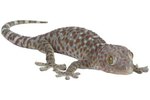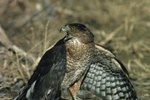
The sun emits energy across a range of wavelengths. Most animals perceive a portion of these wavelengths as visible light, but many wavelengths of light are invisible. Some of these invisible wavelengths -- specifically those in the ultraviolet portion of the spectrum -- are important to animal health. The UVB requirements of many species have not been determined empirically; veterinarians and hobbyists must rely on anecdotal knowledge to keep their patients and pets healthy.
Invisible Wavelengths
Humans perceive energy with wavelengths between about 750 nanometers and 400 nanometers as visible light. The ultraviolet portion of the spectrum spans those wavelengths from 399 nanometers to those as small as 100 nanometers. Scientists divide the ultraviolet portion of the spectrum into three ranges: UVA, UVB and UVC. UVB light refers to energy with wavelengths between 314 and 280 nanometers.
Having a Need for UVB
For many animals, UVB plays an important role in biological functions, including the metabolism of calcium. Vitamin D3 -- the active form of vitamin D -- is necessary for the proper absorption of calcium. Animals may consume plenty of calcium but, without enough vitamin D3, they cannot utilize this calcium properly. Some animals derive vitamin D3 from their diet, some get it from exposure to light in the UVB portion of the spectrum, and others obtain it via a combination of the two strategies.
Light Beams for Birds
Birds obtain vitamin D3 through exposure to UVB light and through diet. While pet birds should have high-quality lighting, UVB-producing bulbs are, anecdotally at least, not terribly appropriate. UVB lights must be in close proximity to the birds to be effective, so close that they may disrupt the birds' vision and metabolism. They can grow too hot, too. Other logistical concerns exist. Consult your veterinarian, who can suggest a combination of artificial lighting, access to unfiltered sunlight and vitamin D supplementation to keep your pet healthy. Occasional exposure to unfiltered sunlight -- that which has not passed through glass or acrylic -- is also beneficial, as long as you're sure your bird is able to move out of the sun if he gets too warm.
Turtles of the Land and Water
All tortoises require UVB lighting, and most aquatic and terrestrial turtles need it as well. Because turtles require so much calcium for the construction of their shells, it is imperative that their vitamin D3 levels stay at the optimum level. Snapping turtles and other species that eat a lot of whole-animal prey are less likely to require UVB light.
Vegetarians and Sun Worshipers
Herbivorous and insectivorous lizards do not acquire much D3 in their diet, and they generally obtain it from exposure to UVB light. The National Zoo in Washington, D.C., has demonstrated that green iguanas are unable to use dietary vitamin D3 and so must absorb Vitamin D from UVB lighting. Other diurnal lizards with primarily herbivorous diets, including chuckwallas (Sauromalus ssp.) and bearded dragons (Pogona vitticeps) require UVB lighting to remain healthy. Panther chameleons alter their exposure to UVB producing lights in relation to the amount of D3 in their bloodstream when given the opportunity to do so.
Slimy Critters and Gluttons
Snakes and highly carnivorous lizards, such as monitors and tegus, can likely obtain vitamin D3 in sufficient quantities from their diet to alleviate the need for UVB lighting. Additionally, nocturnal lizards -- including most geckos -- do not require UVB lighting. In a 1991 monograph published in “ILAR Journal,” Herpetologist F. Harvey Pough suggested that UVB lights are not appropriate for forest-dwelling reptiles and amphibians.
Creatures of the Night
Nocturnal rodents and similar mammals require very little vitamin D to survive. This may have allowed rodents and mammals to survive the asteroid impact and resulting dust-induced darkness that killed the dinosaurs about 65 million years ago. Accordingly, pet rodents and small mammals do not require UVB lights.
References
- Georgia State University: The Electromagnetic Spectrum
- Ilar Journal: Recommendations for the Care of Amphibians and Reptiles in Academic Institutions
- Biologic Effects of Light: Evaluation of Vitamin D Status in the Green Iguana (Iguana Iguana): Oral Administration vs UVB Exposure
- WildlifeRehabber.com: Using Full Spectrum Lighting With Birds
- International Varanid Interest Group: Restoring Vitamin D in Monitor Lizards: Are Dietary and UVB Sources Equivalent?
- Clinical Journal of the American Society of Nephrology: Vitamin D and Sunlight: Strategies for Cancer Prevention and Other Health Benefits
Photo Credits
-
John Foxx/Stockbyte/Getty Images




